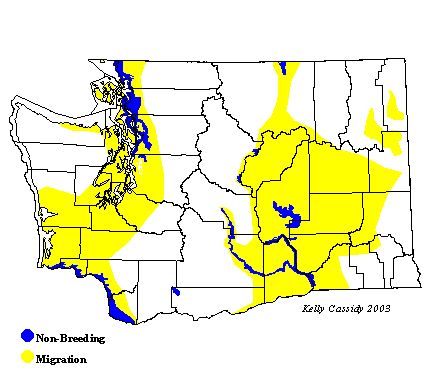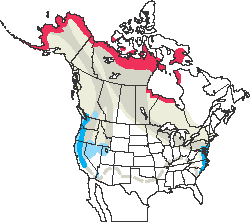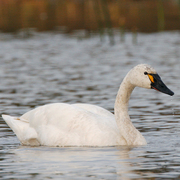Tundra Swan
General Description
Known by many in North America as the Whistling Swan, the Tundra Swan is a large, white bird, with a long neck held straight up. It has a black bill with yellow patches in front of its eyes, although the yellow is not always present. The juvenile is gray with a pink bill and black legs, but it becomes whiter through the winter because of continuous molting. Males and females look alike.
Habitat
Tundra Swans nest in the wet Arctic tundra and are generally found near the coast. During migration and through the winter, they inhabit shallow lakes, slow-moving rivers, flooded fields, and coastal estuaries. When Trumpeter Swans first reappeared in Washington, there was a habitat separation between the two swans, with the Trumpeters on fresh water and Tundras on salt water. This separation is no longer seen, and mixed flocks are common.
Behavior
During the breeding season, Tundra Swans forage mostly on the water, using their long necks to reach as much as three feet below the water's surface. During migration and in winter, much of their feeding is on land in fields. A long-lived species, they form long-term pair bonds.
Diet
Historically Tundra Swans ate invertebrates and submerged, aquatic vegetation, but severe declines in this food at migratory stopover and wintering areas have led the swans to shift to a winter diet of mostly grains and cultivated tubers left in agricultural fields through the winter. In summer, their diet consists of new shoots, tubers, and seeds.
Nesting
Nests are located near a lake or other open water, in an area with good visibility. Both parents help build the nest, which is a large, low mound of plant material with a depression in the center. The pair may reuse the nest from year to year. The female incubates the 4 to 5 eggs for about a month, with the male assisting. After the eggs hatch, both parents tend the young, leading them to sources of food where the young feed themselves. They first fly at 2 to 3 months, but stay with the parents at least through the first winter.
Migration Status
Tundra Swans migrate long distances in family groups. They leave the nesting area in late summer and stage in nearby estuaries before heading to the wintering grounds in mid-fall. In the spring, the birds make shorter flights with more stopovers than in the fall.
Conservation Status
The most numerous and widespread of the North American swans, the Tundra Swan is less affected by human settlement than the larger Trumpeter Swan. Destruction of wetlands in the winter range has reduced former food sources, but the Tundra Swan has adapted by shifting its winter habitat to agricultural fields. Lead poisoning has long been a problem for this species, because ingesting only a few lead pellets can kill a swan. This usually affects only a few birds, but large die-offs have occurred. The population appears stable. Limited hunting occurs in some western states, but not Washington.
When and Where to Find in Washington
Tundra Swans are common in fresh- and saltwater habitats throughout the lowlands of northwestern Washington from November to April. Almost 2,000 winter in Skagit County. In eastern Washington, wintering swans are present, but less common, from mid-November to mid-March, and are more common during migration (mid-March to mid-April, and mid-October to mid-November). Small flocks come through the Turnbull National Wildlife Refuge (Spokane County), and about a thousand winter at the Ridgefield National Wildlife Refuge (Clark County) along the Columbia River.
 Abundance
Abundance
| Ecoregion | Jan | Feb | Mar | Apr | May | Jun | Jul | Aug | Sep | Oct | Nov | Dec |
|---|---|---|---|---|---|---|---|---|---|---|---|---|
| Oceanic | ||||||||||||
| Pacific Northwest Coast | U | U | U | R | R | R | U | U | ||||
| Puget Trough | C | C | C | U | U | C | C | |||||
| North Cascades | ||||||||||||
| West Cascades | C | C | C | U | F | C | C | |||||
| East Cascades | R | R | R | R | R | |||||||
| Okanogan | U | F | U | F | U | |||||||
| Canadian Rockies | F | F | F | F | U | F | F | |||||
| Blue Mountains | R | R | R | R | ||||||||
| Columbia Plateau | U | F | F | R | F | F | U |
Washington Range Map

North American Range Map


Family Members
 Fulvous Whistling-DuckDendrocygna bicolor
Fulvous Whistling-DuckDendrocygna bicolor Taiga Bean-GooseAnser fabalis
Taiga Bean-GooseAnser fabalis Greater White-fronted GooseAnser albifrons
Greater White-fronted GooseAnser albifrons Emperor GooseChen canagica
Emperor GooseChen canagica Snow GooseChen caerulescens
Snow GooseChen caerulescens Ross's GooseChen rossii
Ross's GooseChen rossii BrantBranta bernicla
BrantBranta bernicla Cackling GooseBranta hutchinsii
Cackling GooseBranta hutchinsii Canada GooseBranta canadensis
Canada GooseBranta canadensis Mute SwanCygnus olor
Mute SwanCygnus olor Trumpeter SwanCygnus buccinator
Trumpeter SwanCygnus buccinator Tundra SwanCygnus columbianus
Tundra SwanCygnus columbianus Wood DuckAix sponsa
Wood DuckAix sponsa GadwallAnas strepera
GadwallAnas strepera Falcated DuckAnas falcata
Falcated DuckAnas falcata Eurasian WigeonAnas penelope
Eurasian WigeonAnas penelope American WigeonAnas americana
American WigeonAnas americana American Black DuckAnas rubripes
American Black DuckAnas rubripes MallardAnas platyrhynchos
MallardAnas platyrhynchos Blue-winged TealAnas discors
Blue-winged TealAnas discors Cinnamon TealAnas cyanoptera
Cinnamon TealAnas cyanoptera Northern ShovelerAnas clypeata
Northern ShovelerAnas clypeata Northern PintailAnas acuta
Northern PintailAnas acuta GarganeyAnas querquedula
GarganeyAnas querquedula Baikal TealAnas formosa
Baikal TealAnas formosa Green-winged TealAnas crecca
Green-winged TealAnas crecca CanvasbackAythya valisineria
CanvasbackAythya valisineria RedheadAythya americana
RedheadAythya americana Ring-necked DuckAythya collaris
Ring-necked DuckAythya collaris Tufted DuckAythya fuligula
Tufted DuckAythya fuligula Greater ScaupAythya marila
Greater ScaupAythya marila Lesser ScaupAythya affinis
Lesser ScaupAythya affinis Steller's EiderPolysticta stelleri
Steller's EiderPolysticta stelleri King EiderSomateria spectabilis
King EiderSomateria spectabilis Common EiderSomateria mollissima
Common EiderSomateria mollissima Harlequin DuckHistrionicus histrionicus
Harlequin DuckHistrionicus histrionicus Surf ScoterMelanitta perspicillata
Surf ScoterMelanitta perspicillata White-winged ScoterMelanitta fusca
White-winged ScoterMelanitta fusca Black ScoterMelanitta nigra
Black ScoterMelanitta nigra Long-tailed DuckClangula hyemalis
Long-tailed DuckClangula hyemalis BuffleheadBucephala albeola
BuffleheadBucephala albeola Common GoldeneyeBucephala clangula
Common GoldeneyeBucephala clangula Barrow's GoldeneyeBucephala islandica
Barrow's GoldeneyeBucephala islandica SmewMergellus albellus
SmewMergellus albellus Hooded MerganserLophodytes cucullatus
Hooded MerganserLophodytes cucullatus Common MerganserMergus merganser
Common MerganserMergus merganser Red-breasted MerganserMergus serrator
Red-breasted MerganserMergus serrator Ruddy DuckOxyura jamaicensis
Ruddy DuckOxyura jamaicensis

